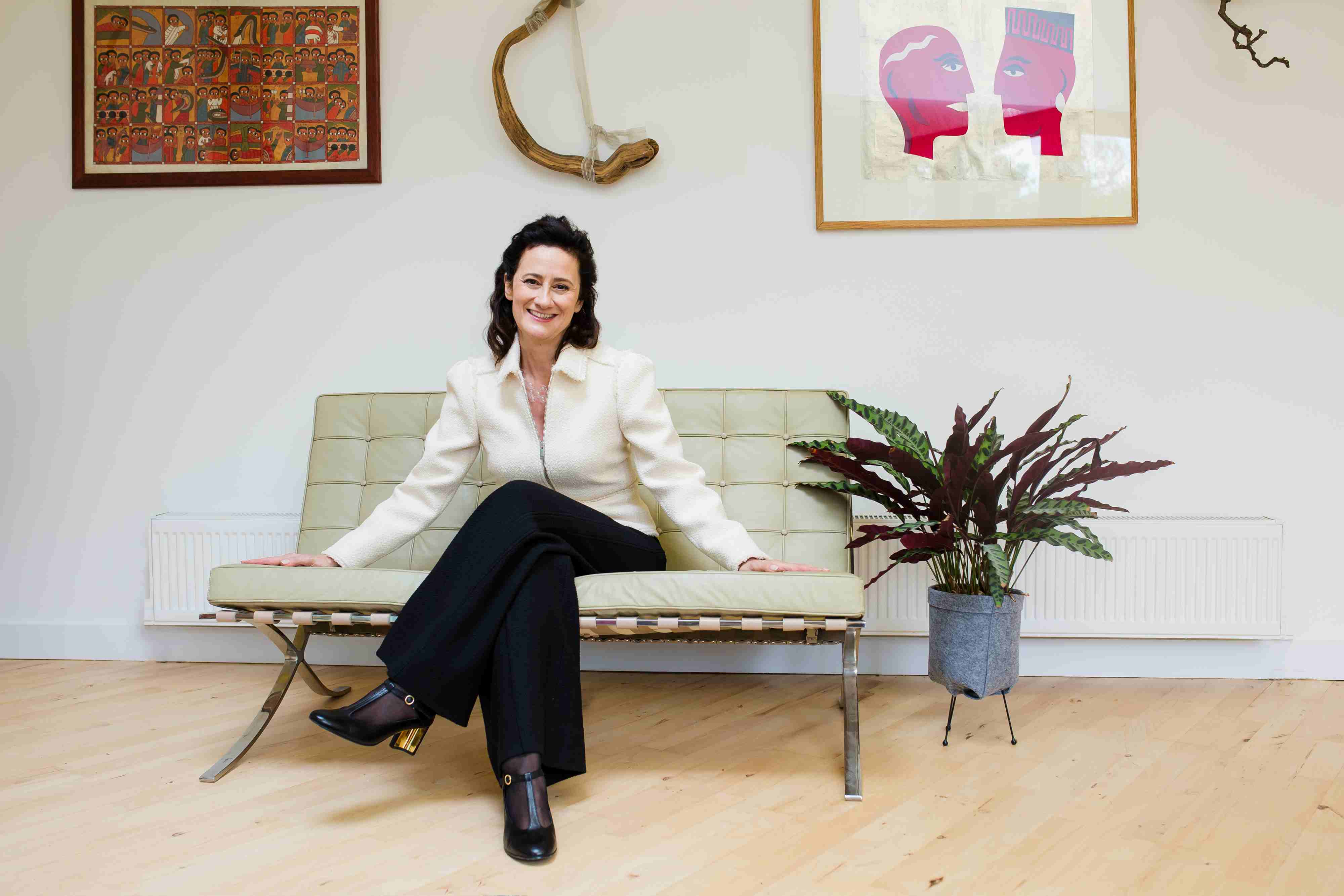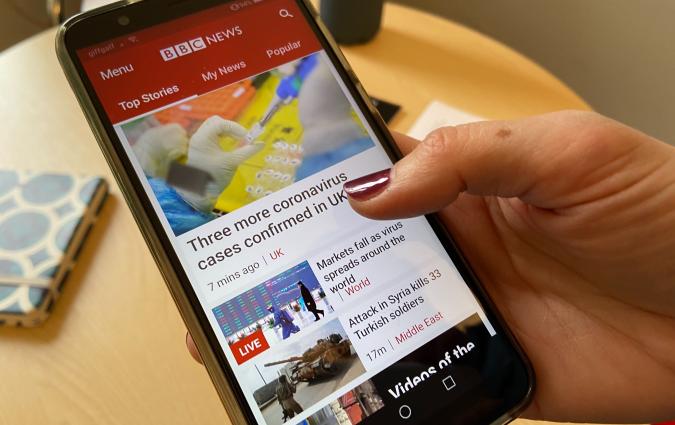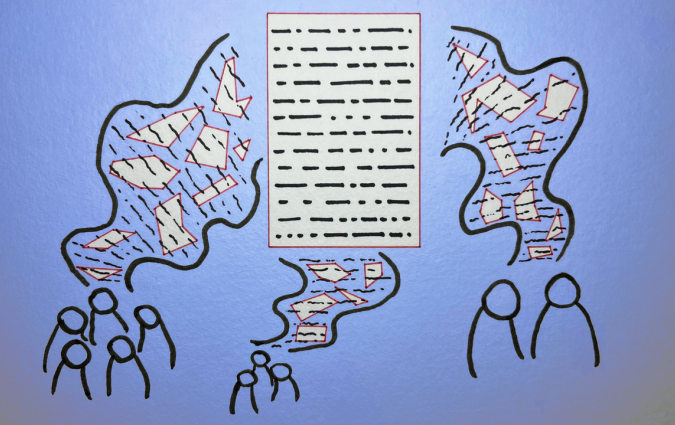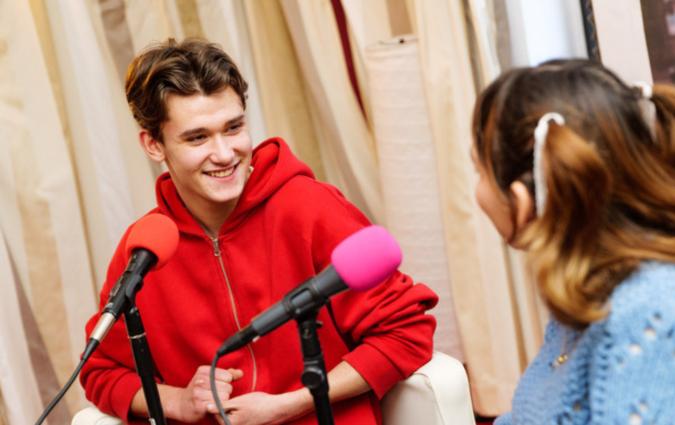This journalist wants you to listen more deeply

Emily Kasriel. | Credit: Belinda Burton
Do journalists listen to their interviewees? Not deeply enough, according to journalist and media executive Emily Kasriel, who just published Deep Listening, a book partly inspired by her own experience at the BBC. Kasriel’s book presents a practical eight-step framework for people to practice ‘deep listening’, a term popularised by American composer Pauline Oliveros.
Our former Journalist Fellow Daniel Clarke spent his time at the Institute in 2020 looking at how Oliveros' approach can be adopted by journalists through deep listening and ‘engaged journalism’. This was in part driven by a desire to understand how people think and feel following events like Brexit and the 2016 election of Donald Trump, both of which many journalists and media outlets struggled to explain.
Deep listening focuses on connection and understanding, Kasriel writes, and can be achieved through creating a safe environment for the speaker to share, managing distractions and inner thoughts, and engaging with curiosity, empathy, and respect. Other tools to listen deeply are embracing silences, signalling your attention through body language, and reflecting back to the speaker the very core of what you understand they are telling you, including their emotions and the notes between the words.
I spoke to Kasriel before the launch of the book to ask how deep listening can be applied to journalism, what its limitations are, and how her own experiences as a journalist contributed to the development of her ideas. Our conversation has been edited for clarity and length.
Q. Can you give a brief introduction to deep listening?
A. When we normally listen, we listen in a performative way, or we listen as a journalist to extract information from somebody: we know exactly what we want and we're waiting for them to give us that soundbite if we are doing the interview for TV, radio or a podcast. We aren't open to listening to what might unfold. So, we are often preloading our verbal gun with the next question, ready to fire, when we listen to somebody. We might even interrupt them with a great follow-up question to take them down the avenue that we think is most important for our piece. Or we listen in a way that assumes that we already know what they're going to think, so we're not genuinely curious.
Deep listening is about conversations where we don't assume that we already understand. It's about using curiosity to try and see the world from another person's perspective and temporarily withholding judgment to accept that person holds these perspectives. It's not about agreeing.
Q. How did you first come across the concept of deep listening?
A. I was head of special projects at the BBC for a decade until I left in 2023. Through that work, I led a big solutions-focused journalism project across BBC News. And to get more support for that project, I led some big seasons, including SoICanBreathe, on air pollution, and Crossing Divides, which was all about getting the whole of the BBC to tell stories of people engaging across differences. In doing so, I had to brief 39 local radio producers in England on how to have constructive conversations and realised I needed to know more.
Alongside my work at the BBC, I was also a practitioner in residence at [the London School of Economics], and I'm now a senior visiting research fellow at the Policy Institute at King's College [in London]. I started to do more research about what it would take to have a profound encounter, especially when we disagree. It's through this research and my own experience that I have evolved this eight-step approach and have written this book about it.
Q. Was it inspired by your work as a journalist?
A. It was, at least in part. As a journalist, I realised that often I didn't listen. I was formulating what I thought was my next brilliant question. I wasn't truly engaging with the person in a way that would invite them to think more deeply and tell a truer story.
For example, I write in the book about a time when I interviewed Ethiopian President Meles Zenawi in my very early days as a journalist. I was so keen on confronting him about the human rights abuses reported to me by dissidents that I wasn't open to hearing from someone who was, in fact, a remarkably thoughtful man. And it wasn't that I was wrong to hold him accountable for the abuses in the country. It's just that I could have also enabled him to share a much more interesting story, which I failed to do. In fact, he stopped the interview early because he could see I wasn't listening.
Q. How would you have led that interview differently if you had pursued deep listening? Is it compatible with holding people to account?
A. I don't think these things are exclusive. It was probably the tone with which I held President Zenawi to account that made him feel judged. When people feel judged, they put up their defences, and they just talk at the surface level. Even when he was defending his record, if I had conveyed an openness to truly understand him, he would have revealed more, and we would have gone down a different avenue. I could have still come back to him and held him to account, but it would have created a very different relationship from the one that we had in that interview, which was weak, evidenced by the fact that he ended it early. During the interview, he withdrew further and further away. I remember my arm outstretched holding the microphone, across this enormous presidential desk, as Zenawi retreated into the very corner.
Q. Do you think that this attitude towards understanding people and wanting to place yourself in their shoes in an interview might lead to unintentionally giving somebody a platform, or explaining away bad behaviour?
A. Not necessarily. A perfect example is a story I discuss in the book: I went to interview Philip Davies, a dairy farmer who does not believe in climate science and does not accept that there is human-induced climate change. I disagreed with him, like most scientists, but I wanted to understand his perspective.
Through meeting Davies over two days at his farm on the border between England and Wales, I was able to ascertain that he saw climate change as yet another example of the mandarins in Whitehall [the British civil service], these people who had no lived experience of farming, getting at the farmers. When I wrote up this piece for BBC Future, I put his thoughts in the context of a lot of climate science, the fact that dairy farmers are contributing significantly to the warming of our planet. And yet, because I conveyed his deeper narrative in the piece, this farmer still felt heard.
I spent a couple of days just before the first US inauguration of Donald Trump as president, talking and listening to Trump supporters. I tried to truly understand their enormous enthusiasm for Trump, as well as raising issues about the way that Trump had talked about women, for example. One woman told me at the end of our conversation that she was surprised that I was genuinely curious and accepted her right to hold her view. I believe that a lot of people aren't being properly heard, and it's the job of journalists to understand them better, convey their impressions and provide the necessary context.
Q. What makes deep listening different to typical journalism interview techniques?
A. The very best journalists use lots of aspects of deep listening. For example, journalists like Lyse Doucet or Mark Easton demonstrate their desire to understand the perspectives of those they are interviewing. They appreciate that they can use empathy, and it doesn't mean they agree with the opinions of their interviewees.
Journalists are often rushed, but the quality of their attention is so important in order that their interviewee feels that the journalist is fully present with them.
Sometimes when we're talking to somebody we know we find objectionable, we can take the time to deal with our own emotions and feelings so that when we meet them, we don’t behave as I did with the President of Ethiopia, coming to the interview as somebody solely focussed on confronting the President on his policies and actions.
The role of journalists is to gather and tell stories. But so often people speak, as the critic and philosopher George Steiner said, at the surface of themselves. Especially in places like America, where people have great pre-prepared responses, or in Nigeria, where people have got fantastic vox pops ready to present to journalists which don't reveal what they truly feel and think.
That's partly the role of journalists, to elicit what people genuinely believe. This deep listening approach is not suited for when you're collecting a very quick news bite that you need for that day's news show. But with a lot of stories, we need to more fully understand the deeper narratives that lie behind people’s surface impressions, to include their motivations and their values.
Q. What are the ideal situations where you think journalists should use deep listening versus when it might not be appropriate?
A. When we're collecting news stories, and especially when we disagree with an interviewee’s ideas, we may put them in a pre-packaged box. It’s like going around an exhibition and just saying, ‘That's impressionism. That's postmodernism,’ and never really looking at the pictures. That's the way journalists often treat people. People have many different identities, not just one. By telling a more nuanced, complicated story, we enable our audiences to gain a truer, more authentic picture of reality.
Q. Are there any current journalistic practices that you think we need to leave in the past? For example, vox pops?
A. Not really. There are so many different goals for different types of journalism and different formats. I'm not that prescriptive. The question is how you carry out that vox pop, whether you already know what you want to gather before you talk to somebody. You need to pre-think to some extent when you're on a tight deadline. But I hope to inspire journalists to consider a new way of listening, in a way that makes sense for them.
Deep listening is also about trying new methods of being present, trying to leave some silence after an interviewee has spoken, not as an intimidating tactic, but just to give their interviewee some space to think and reflect. Deep listening isn't the kind of active listening that people have learnt in management courses. It's about reflecting the very core of what somebody has said and what they have not said, and offering it back with humility to check in with them, for them to say yes or you haven't got it right, so that they can go deeper rather than just skating on the surface.
Q. Tell me more about the ‘shadows’ that can negatively impact a conversation. For a journalist, is it accurate to say that these are internal biases?
A. These shadows are especially relevant if there's a difficult interview coming up, or the journalist is a bit nervous, or feels it's a community which they don't know well. Before they have that interview, journalists should take the time to listen to themselves first. They need to consider, ‘What's going on here? What's at stake for me?’ Because until people can do that, when they're conducting the interview, they won’t be listening to a person, they won’t be engaging and trying to truly understand. They'll just be listening masked by the filter of their preconceived ideas and biases, or projecting their shadows onto that individual.
Deep listening to themselves first can help surface these. If you know what's going on in your psyche, then you'll be in a better position to be more open. It's an openness to be surprised by what you hear.
Q. You worked for the BBC for many years, an outlet known for its focus on impartiality. Has this concept affected your interpretation of deep listening?
A. What's important is that, when you deeply listen, it does not mean you agree. I've found that people all over the world, journalists and others, are reticent to listen, and sometimes to show empathy, fearing that such listening signals agreement. Listening deeply, however, doesn't mean that you agree or that you can’t ask difficult questions that hold interviewees to account. It does not mean you don't put interviewees’ ideas in context, like I did with the dairy farmer. But having a rapport with them, respecting their inherent dignity as a complex human being, enables you to understand them more fully.
Q. What are the first steps a journalist can take towards deeper listening?
A. Being curious, not assuming you already know when you do an interview. Assume instead that you might not know, and that new ideas may unfold that perhaps your speaker has not articulated before. Being in that space of unknowing, I think, is exciting. And then practising that presence. Leave for a moment your next pre-formulated question. Instead, be there with what's happening in that room, and perhaps articulate it.
For example, if you sense somebody's been quite hesitant, if the interview is not going very well, say that. Be authentic. ‘I'm sensing that perhaps you're a little hesitant to speak. Is that right?’ And they can then clarify, and suddenly you're having a genuine conversation.
There is also an ethical responsibility with deep listening because people often share more than they intended to share. People trust you more when you deeply listen to them. Therefore, there's an obligation to check in with them to ensure that your understanding is correct and they're happy for that to be shared.
It's not easy to deeply listen because our experiences and preconceptions shape what we can hear and what we can't hear. As journalists, we are so often distracted by deadlines and pre-formed narratives and pressure to secure that soundbite. But deep listening is about temporarily surrendering our agenda and reflecting on what the interviewee truly means. Through this approach, we invite these more authentic stories, and we can capture what we normally might not. Then the work of a journalist becomes an awful lot more interesting, and the stories they collect and tell become far more profound.
In every email we send you'll find original reporting, evidence-based insights, online seminars and readings curated from 100s of sources - all in 5 minutes.
- Twice a week
- More than 20,000 people receive it
- Unsubscribe any time







